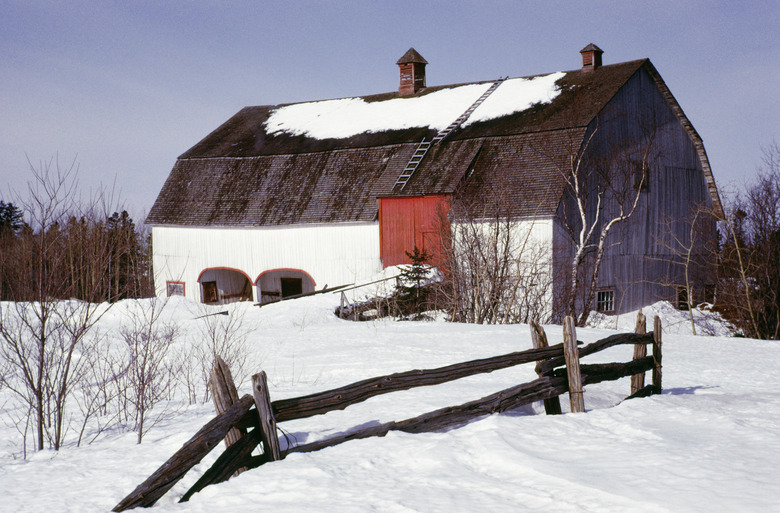Fertilizer Pollution Of Aquatic Ecosystems
Fertilizer runoff tops the list of pollutants affecting aquatic ecosystems in North America. When it comes to figuring out where this pollution actually originates, however, and how to stop it, answers are rarely simple or clear-cut. These pollutants have a plethora of sources, and though they're all considered soil "nutrients," they don't always come from intentional application on farmland or even necessarily from "fertilizers."
Nonpoint Source Pollution
Nonpoint Source Pollution
Fertilizer pollution is officially known as nonpoint source pollution. This rather vague label includes agricultural runoff as well as all pollutants originating from homes, lawns and storm drains. It's called nonpoint source because it's impossible to pinpoint a single source for these pollutants once they've made their way into aquatic ecosystems.
Chemical Sources
Chemical Sources
Chemical fertilizer applied to the United States' 330 million acres of farmland is a primary culprit in fertilizer pollution. These fertilizers contain phosphorus and nitrogen — the most basic components of aquatic nutrient pollution. Chemical fertilizers applied to urban and suburban lawns and recreational facilities are also at fault. When overapplied, applied just before rainfall or snowmelt or allowed to hit a hard surface such as asphalt or icy ground, these chemicals readily wash off the treatment area and into bodies of water.
The Straight Poop
The Straight Poop
While it's easy to point the finger at farmers applying chemical fertilizers, it turns out that laying the blame isn't quite so simple. A very large portion — no one is sure exactly how large — of "agricultural" or "fertilizer pollution" comes in the form of all-natural animal manure — but not necessarily manure applied as fertilizer. The U.S. Environmental Protection Agency reports that a main source of this waterway pollution is actually improperly disposed off or stored waste from animal feeding operations — you may know them as "factory farms."
Lawns and Leaves
Lawns and Leaves
A third source of fertilizer pollution is simple lawn clippings and raked leaves. These probably aren't on your radar as "fertilizers," but according to the University of Minnesota Extension, leaves and lawn clippings washed from storm drains into aquatic ecosystems are a major source of phosphorus pollution.
How It Happens
How It Happens
The simple fact of a nutrient existing in or on the soil doesn't mean it will eventually pollute aquatic ecosystems. The two main nutrient pollutants, nitrogen and phosphorus, are necessary for plant growth, after all, and should be in soil. Under ideal circumstances, phosphorus bonds to soil and stays put, and nitrogen it taken up by plants, where it stays for the plants' life cycle. Problems occur when there's too much of the nutrients — they wash away before plants have time to incorporate them or when there's soil erosion. In turn, the nutrients wash into waterways with eroding soil.
What It Does
What It Does
Scientists call it eutrophication. It means enrichment with nutrients, which is where the paradox of nutrient pollution comes in — large amounts of necessary plant nutrients create dead zones in aquatic ecosystems. They do this by causing algal blooms, which rob the water of oxygen. The phenomenon happens two ways. In the first scenario, some of these "algae" aren't actually plants. They're nonphotosynthetic protozoa or bacteria, which use oxygen. The second is when photosynthetic algae grow out of control. Entire communities of microbes and small animals — far more than would naturally occur in an area — are attracted to the super-abundance of oxygen and nutrients in these growths. All is well until nightfall, when photosynthesis stops. The algae stop producing oxygen when it's dark, but the other organisms don't stop needing it. They quickly use up the available oxygen and suffocate by morning, leaving large tracts of aquatic ecosystems entirely devoid of life.
References
- University of Minnesota Extension: Preventing Pollution Problems from Lawn and Garden Fertilizers
- Reuters: U.S. Farmers Should Curb Fertilizer Runoff – Study
- U.S. Environmental Protection Agency: Water – Polluted Runoff – Agriculture
- U.S. Environmental Protection Agency: Agricultural Nonpoint Source Fact Sheet
- Greenpeace Canada: Dead Zones – How Agricultural Fertilizers Are Killing Our Rivers, Lakes and Oceans
- Greenpeace Canada: Gulf of California – Excessive Fertilizer Use and Algae Blooms
Cite This Article
MLA
Libal, Angela. "Fertilizer Pollution Of Aquatic Ecosystems" sciencing.com, https://www.sciencing.com/fertilizer-pollution-aquatic-ecosystems-4587/. 24 April 2017.
APA
Libal, Angela. (2017, April 24). Fertilizer Pollution Of Aquatic Ecosystems. sciencing.com. Retrieved from https://www.sciencing.com/fertilizer-pollution-aquatic-ecosystems-4587/
Chicago
Libal, Angela. Fertilizer Pollution Of Aquatic Ecosystems last modified August 30, 2022. https://www.sciencing.com/fertilizer-pollution-aquatic-ecosystems-4587/
